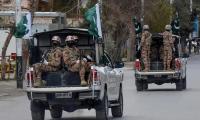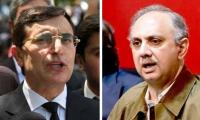This year, India’s growth rate is expected to reach 8 per cent – highest among all large countries. Its exports touched $670 billion, and it has foreign reserves of $630 billion. The picture is equally impressive for Bangladesh – 7 per cent growth rate, exports of $45 billion and reserves of $44 billion. These countries are galloping away, while Pakistan is struggling and fast approaching economic and social collapse like Sri Lanka.
Pakistan’s 220 million are spiraling into a vortex as a result of: (i) economic mismanagement by all governments, out-of-control government expenditures and SOE losses, untargeted subsidies, harmful fixed exchange rate policies of the previous PML-N government, and the PTI’s unwillingness to work with the opposition; and (ii) the game of thrones being played by the cabal of mostly corrupt marshals of the jungle, keepers of the laws, and evangelists of mostly half-truth narratives. If Pakistan goes over the cliff, the blame will squarely lie on its political, military, and judicial leadership and the elite class which has continued to lead an extravagant lifestyle at Pakistan’s expense.
Pakistan urgently needs a political consensus on an ‘economic emergency’ plan, fully backed by the military and the judiciary, to avoid a complete meltdown. Painful and difficult actions are needed over the next couple of months to stop the gushing twin hemorrhages: over-spending and over-importing.
Pakistan must immediately try to restart IMF funding by presenting its economic emergency programme, which needs to be bold and credible so that the IMF as well as friendly nations enthusiastically come back to the table on Pakistan’s terms. Any programme to plug the twin deficits would require major cutbacks in expenditures and imports, but must also not include any action that further increases the cost of living of urban low-income families – the millions who can ignite the tinderbox at the slightest increase in their cost of living. Once the match is lit in cities across Pakistan, neither political parties nor the military nor the judiciary can stop the flames from engulfing Pakistan – a chaos that India will support.
The economic emergency programme must have the following clear objectives over the next 12 months: 50 per cent reduction from this year’s fiscal and current account deficit, by reducing fiscal deficit by Rs2 trillion and imports by $10 billion. A significant part of this adjustment must be achieved in the first three months, to avoid an economic crisis and give credibility to the reform programme. Also, the majority of this adjustment and belt tightening must be borne by middle- and upper-income households, to send a clear signal that this time Pakistan’s elite will be bailing out Pakistan.
The reform programme must comprise the following measures. First, for the next couple of years, Pakistan must – through tax and credit policies – restrict growth of all highly import dependent industries (cars, white goods, electronics etc) producing for the domestic market. Our economic foundations are mostly quicksand. At best we can construct a one-or-two-storey building, but we insist on building a four-storey building – which comes crashing down every few years.
Second, declaring the premise of every exporting industry as tax-free bonded manufacturing, and ensuring that they get all utilities at regionally competitive prices and subsidized credit. Bangladesh has over 6000 bonded manufacturing units, which account for 90 per cent of its exports, while Pakistan has a handful.
Third, using technology, provide Rs1 trillion of targeted subsidies as digital cash directly to 30 million low-income and poor families – all families currently under BISP/Ehsaas, and those owning motorcycles. Targeted subsidy should be provided for one year, for electricity, petroleum products, essential food items (flour, edible oil, lentils, and sugar) and agriculture inputs. Through NADRA and the vehicle registration database, owners of motorcycles and tractors can within a month be linked to a CNIC/cell phone, and subsidy directly transferred to them.
In four years, India digitally disbursed $270 billion to 900 million people. Ehsaas’s success shows that Pakistan can also implement a much larger targeted subsidy programme. Once targeted subsidies are in place, market prices of these goods must be increased dramatically, through high import taxes, so the rich not only pay for the subsidies but also contribute to increasing government revenues.
Fourth, the non-interest government expenditures must be reduced by at least Rs1 trillion through cutting waste in civil and military institutions, drastically cutting back development spending except for dams and water management, shutting down loss-making SOEs and reducing untargeted subsidies.
Fifth, additional Rs1 trillion must be raised from the energy sector by quadrupling petroleum prices, and electricity tariffs for all households using more than 1000 kwh. All Pakistanis who own multiple/luxury cars, and who run air-conditioners indiscriminately must pay through their nose. This is a sacrifice they must make to save Pakistan. The aim should be for the energy sector to become a major source of additional funds to reduce deficit rather than grow it.
Sixth, imposition of a Debt Reduction Tax (DRT) for at least two years to raise Rs2 trillion to reduce public debt. The DRT should be imposed on: (i) all assets (vehicles, agriculture and urban real estate, and PSX shares) of individuals who own assets of more than Rs5 crores; and (ii) capital gains on real estate and shares, and profits of large companies.
In FY21, KSE-100 firms made Rs1 trillion of profits. These profits accrue almost exclusively to the rich, and hence a DRT on profits should be at least 50 per cent. The rate of the DRT for both categories should be such that at least Rs1 trillion is collected each year. This belt tightening of the rich is the need of the hour.
Seventh, suppress lending and deposit interest rates, by 4-5 per cent, for one year. Such policies are harmful over the long run, but can be pursued over the short term and would not lead to capital flight. In cases where lowering of deposits hurts low-income pensioners and widows, who live off interest earning, they can be compensated directly. This action would lower the interest expenses of the government and the private sector. The aim should be to save at least Rs500 billion a year of interest expenses on domestic public debt.
Finally, the use of market based exchange rate to lower imports has mostly run its course. Pakistan should impose a 1-2 year complete ban on imported cars, cell phones, non-essential food and all manufactured home-use goods; rich and ordinary Pakistanis can do without these for a few years. Also very high import duties and taxes should be imposed on edible oil, sugar, lentils and tea to curb imports of these items, along with cash subsidies to the poor. The objective should be to reduce imports by $10 billion next year, through the above measures, reduce government expenditures and lower the demand of petroleum imports by quadrupling the prices of petrol and household electricity.
Once all these measures have achieved their objectives, Pakistan will have a solid foundation to increase growth in the future. It won’t be pretty but desperate times call for desperate measures.
Pakistan is facing an existential crisis, which will worsen if difficult and painful steps are not taken immediately. It is time for all institutions to be on the same page, for politicians to build economic consensus and take difficult decisions, and for the rich to help bail Pakistan out. If they don’t, the meltdown inferno will engulf everyone – especially the rich.
The writer is a former adviser to the World Bank.
MPAs ask for their salaries and benefits to be at par with high court judges and exempt from tax
This system fosters and places premium on VIPs, facilitating VIP culture, which is alive and kicking
Imagine this waste covering over 15,500 cricket stadiums, piled three meters deep every year
If there is one thing that can be gleaned from politics today, it is that we no longer speak same language
Postman argues that “typographic mind” was yielding to “televisual mind”
Pakistan is well poised to meet opportunities that Artificial Intelligence will offer for developments in industries







